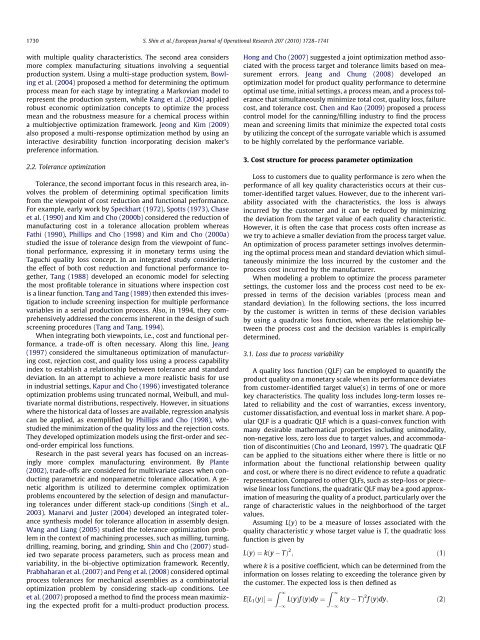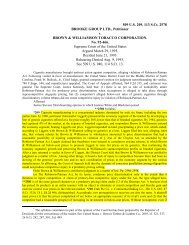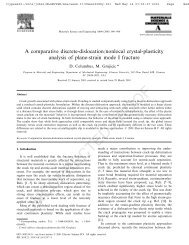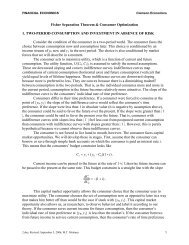Development of the parametric tolerance modeling and optimization ...
Development of the parametric tolerance modeling and optimization ...
Development of the parametric tolerance modeling and optimization ...
Create successful ePaper yourself
Turn your PDF publications into a flip-book with our unique Google optimized e-Paper software.
1730 S. Shin et al. / European Journal <strong>of</strong> Operational Research 207 (2010) 1728–1741<br />
with multiple quality characteristics. The second area considers<br />
more complex manufacturing situations involving a sequential<br />
production system. Using a multi-stage production system, Bowling<br />
et al. (2004) proposed a method for determining <strong>the</strong> optimum<br />
process mean for each stage by integrating a Markovian model to<br />
represent <strong>the</strong> production system, while Kang et al. (2004) applied<br />
robust economic <strong>optimization</strong> concepts to optimize <strong>the</strong> process<br />
mean <strong>and</strong> <strong>the</strong> robustness measure for a chemical process within<br />
a multiobjective <strong>optimization</strong> framework. Jeong <strong>and</strong> Kim (2009)<br />
also proposed a multi-response <strong>optimization</strong> method by using an<br />
interactive desirability function incorporating decision maker’s<br />
preference information.<br />
2.2. Tolerance <strong>optimization</strong><br />
Tolerance, <strong>the</strong> second important focus in this research area, involves<br />
<strong>the</strong> problem <strong>of</strong> determining optimal specification limits<br />
from <strong>the</strong> viewpoint <strong>of</strong> cost reduction <strong>and</strong> functional performance.<br />
For example, early work by Speckhart (1972), Spotts (1973), Chase<br />
et al. (1990) <strong>and</strong> Kim <strong>and</strong> Cho (2000b) considered <strong>the</strong> reduction <strong>of</strong><br />
manufacturing cost in a <strong>tolerance</strong> allocation problem whereas<br />
Fathi (1990), Phillips <strong>and</strong> Cho (1998) <strong>and</strong> Kim <strong>and</strong> Cho (2000a)<br />
studied <strong>the</strong> issue <strong>of</strong> <strong>tolerance</strong> design from <strong>the</strong> viewpoint <strong>of</strong> functional<br />
performance, expressing it in monetary terms using <strong>the</strong><br />
Taguchi quality loss concept. In an integrated study considering<br />
<strong>the</strong> effect <strong>of</strong> both cost reduction <strong>and</strong> functional performance toge<strong>the</strong>r,<br />
Tang (1988) developed an economic model for selecting<br />
<strong>the</strong> most pr<strong>of</strong>itable <strong>tolerance</strong> in situations where inspection cost<br />
is a linear function. Tang <strong>and</strong> Tang (1989) <strong>the</strong>n extended this investigation<br />
to include screening inspection for multiple performance<br />
variables in a serial production process. Also, in 1994, <strong>the</strong>y comprehensively<br />
addressed <strong>the</strong> concerns inherent in <strong>the</strong> design <strong>of</strong> such<br />
screening procedures (Tang <strong>and</strong> Tang, 1994).<br />
When integrating both viewpoints, i.e., cost <strong>and</strong> functional performance,<br />
a trade-<strong>of</strong>f is <strong>of</strong>ten necessary. Along this line, Jeang<br />
(1997) considered <strong>the</strong> simultaneous <strong>optimization</strong> <strong>of</strong> manufacturing<br />
cost, rejection cost, <strong>and</strong> quality loss using a process capability<br />
index to establish a relationship between <strong>tolerance</strong> <strong>and</strong> st<strong>and</strong>ard<br />
deviation. In an attempt to achieve a more realistic basis for use<br />
in industrial settings, Kapur <strong>and</strong> Cho (1996) investigated <strong>tolerance</strong><br />
<strong>optimization</strong> problems using truncated normal, Weibull, <strong>and</strong> multivariate<br />
normal distributions, respectively. However, in situations<br />
where <strong>the</strong> historical data <strong>of</strong> losses are available, regression analysis<br />
can be applied, as exemplified by Phillips <strong>and</strong> Cho (1998), who<br />
studied <strong>the</strong> minimization <strong>of</strong> <strong>the</strong> quality loss <strong>and</strong> <strong>the</strong> rejection costs.<br />
They developed <strong>optimization</strong> models using <strong>the</strong> first-order <strong>and</strong> second-order<br />
empirical loss functions.<br />
Research in <strong>the</strong> past several years has focused on an increasingly<br />
more complex manufacturing environment. By Plante<br />
(2002), trade-<strong>of</strong>fs are considered for multivariate cases when conducting<br />
<strong>parametric</strong> <strong>and</strong> non<strong>parametric</strong> <strong>tolerance</strong> allocation. A genetic<br />
algorithm is utilized to determine complex <strong>optimization</strong><br />
problems encountered by <strong>the</strong> selection <strong>of</strong> design <strong>and</strong> manufacturing<br />
<strong>tolerance</strong>s under different stack-up conditions (Singh et al.,<br />
2003). Manarvi <strong>and</strong> Juster (2004) developed an integrated <strong>tolerance</strong><br />
syn<strong>the</strong>sis model for <strong>tolerance</strong> allocation in assembly design.<br />
Wang <strong>and</strong> Liang (2005) studied <strong>the</strong> <strong>tolerance</strong> <strong>optimization</strong> problem<br />
in <strong>the</strong> context <strong>of</strong> machining processes, such as milling, turning,<br />
drilling, reaming, boring, <strong>and</strong> grinding. Shin <strong>and</strong> Cho (2007) studied<br />
two separate process parameters, such as process mean <strong>and</strong><br />
variability, in <strong>the</strong> bi-objective <strong>optimization</strong> framework. Recently,<br />
Prabhaharan et al. (2007) <strong>and</strong> Peng et al. (2008) considered optimal<br />
process <strong>tolerance</strong>s for mechanical assemblies as a combinatorial<br />
<strong>optimization</strong> problem by considering stack-up conditions. Lee<br />
et al. (2007) proposed a method to find <strong>the</strong> process mean maximizing<br />
<strong>the</strong> expected pr<strong>of</strong>it for a multi-product production process.<br />
Hong <strong>and</strong> Cho (2007) suggested a joint <strong>optimization</strong> method associated<br />
with <strong>the</strong> process target <strong>and</strong> <strong>tolerance</strong> limits based on measurement<br />
errors. Jeang <strong>and</strong> Chung (2008) developed an<br />
<strong>optimization</strong> model for product quality performance to determine<br />
optimal use time, initial settings, a process mean, <strong>and</strong> a process <strong>tolerance</strong><br />
that simultaneously minimize total cost, quality loss, failure<br />
cost, <strong>and</strong> <strong>tolerance</strong> cost. Chen <strong>and</strong> Kao (2009) proposed a process<br />
control model for <strong>the</strong> canning/filling industry to find <strong>the</strong> process<br />
mean <strong>and</strong> screening limits that minimize <strong>the</strong> expected total costs<br />
by utilizing <strong>the</strong> concept <strong>of</strong> <strong>the</strong> surrogate variable which is assumed<br />
to be highly correlated by <strong>the</strong> performance variable.<br />
3. Cost structure for process parameter <strong>optimization</strong><br />
Loss to customers due to quality performance is zero when <strong>the</strong><br />
performance <strong>of</strong> all key quality characteristics occurs at <strong>the</strong>ir customer-identified<br />
target values. However, due to <strong>the</strong> inherent variability<br />
associated with <strong>the</strong> characteristics, <strong>the</strong> loss is always<br />
incurred by <strong>the</strong> customer <strong>and</strong> it can be reduced by minimizing<br />
<strong>the</strong> deviation from <strong>the</strong> target value <strong>of</strong> each quality characteristic.<br />
However, it is <strong>of</strong>ten <strong>the</strong> case that process costs <strong>of</strong>ten increase as<br />
we try to achieve a smaller deviation from <strong>the</strong> process target value.<br />
An <strong>optimization</strong> <strong>of</strong> process parameter settings involves determining<br />
<strong>the</strong> optimal process mean <strong>and</strong> st<strong>and</strong>ard deviation which simultaneously<br />
minimize <strong>the</strong> loss incurred by <strong>the</strong> customer <strong>and</strong> <strong>the</strong><br />
process cost incurred by <strong>the</strong> manufacturer.<br />
When <strong>modeling</strong> a problem to optimize <strong>the</strong> process parameter<br />
settings, <strong>the</strong> customer loss <strong>and</strong> <strong>the</strong> process cost need to be expressed<br />
in terms <strong>of</strong> <strong>the</strong> decision variables (process mean <strong>and</strong><br />
st<strong>and</strong>ard deviation). In <strong>the</strong> following sections, <strong>the</strong> loss incurred<br />
by <strong>the</strong> customer is written in terms <strong>of</strong> <strong>the</strong>se decision variables<br />
by using a quadratic loss function, whereas <strong>the</strong> relationship between<br />
<strong>the</strong> process cost <strong>and</strong> <strong>the</strong> decision variables is empirically<br />
determined.<br />
3.1. Loss due to process variability<br />
A quality loss function (QLF) can be employed to quantify <strong>the</strong><br />
product quality on a monetary scale when its performance deviates<br />
from customer-identified target value(s) in terms <strong>of</strong> one or more<br />
key characteristics. The quality loss includes long-term losses related<br />
to reliability <strong>and</strong> <strong>the</strong> cost <strong>of</strong> warranties, excess inventory,<br />
customer dissatisfaction, <strong>and</strong> eventual loss in market share. A popular<br />
QLF is a quadratic QLF which is a quasi-convex function with<br />
many desirable ma<strong>the</strong>matical properties including unimodality,<br />
non-negative loss, zero loss due to target values, <strong>and</strong> accommodation<br />
<strong>of</strong> discontinuities (Cho <strong>and</strong> Leonard, 1997). The quadratic QLF<br />
can be applied to <strong>the</strong> situations ei<strong>the</strong>r where <strong>the</strong>re is little or no<br />
information about <strong>the</strong> functional relationship between quality<br />
<strong>and</strong> cost, or where <strong>the</strong>re is no direct evidence to refute a quadratic<br />
representation. Compared to o<strong>the</strong>r QLFs, such as step-loss or piecewise<br />
linear loss functions, <strong>the</strong> quadratic QLF may be a good approximation<br />
<strong>of</strong> measuring <strong>the</strong> quality <strong>of</strong> a product, particularly over <strong>the</strong><br />
range <strong>of</strong> characteristic values in <strong>the</strong> neighborhood <strong>of</strong> <strong>the</strong> target<br />
values.<br />
Assuming L(y) to be a measure <strong>of</strong> losses associated with <strong>the</strong><br />
quality characteristic y whose target value is T, <strong>the</strong> quadratic loss<br />
function is given by<br />
LðyÞ ¼kðy TÞ 2 ; ð1Þ<br />
where k is a positive coefficient, which can be determined from <strong>the</strong><br />
information on losses relating to exceeding <strong>the</strong> <strong>tolerance</strong> given by<br />
<strong>the</strong> customer. The expected loss is <strong>the</strong>n defined as<br />
E½L1ðyÞŠ ¼<br />
Z 1<br />
1<br />
LðyÞf ðyÞdy ¼<br />
Z 1<br />
1<br />
kðy TÞ 2 f ðyÞdy; ð2Þ
















